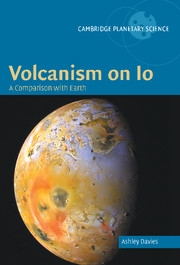Book contents
- Frontmatter
- Contents
- Preface
- List of Abbreviations
- Reproduction Permissions
- Introduction
- Section 1 Io, 1610 to 1995: Galileo to Galileo
- 1 Io, 1610–1979
- 2 Between Voyager and Galileo: 1979–1995
- 3 Galileo at Io
- Section 2 Planetary volcanism: evolution and composition
- Section 3 Observing and modeling volcanic activity
- Section 4 Galileo at Io: the volcanic bestiary
- Section 5 Volcanism on Io: the global view
- Section 6 Io after Galileo
- Appendix 1 Io hot-spot locations
- Appendix 2 Io maps
- References
- Index
- Plate Section
2 - Between Voyager and Galileo: 1979–1995
Published online by Cambridge University Press: 05 October 2014
- Frontmatter
- Contents
- Preface
- List of Abbreviations
- Reproduction Permissions
- Introduction
- Section 1 Io, 1610 to 1995: Galileo to Galileo
- 1 Io, 1610–1979
- 2 Between Voyager and Galileo: 1979–1995
- 3 Galileo at Io
- Section 2 Planetary volcanism: evolution and composition
- Section 3 Observing and modeling volcanic activity
- Section 4 Galileo at Io: the volcanic bestiary
- Section 5 Volcanism on Io: the global view
- Section 6 Io after Galileo
- Appendix 1 Io hot-spot locations
- Appendix 2 Io maps
- References
- Index
- Plate Section
Summary
After the Voyager encounters, analysis of the data continued. More hot spots were identified in IRIS data (see McEwen et al., 1996; also see Appendix 1). Early post-Voyager models of Io incorporated a sulphur-rich crust with an ocean of sulphur beneath (e.g., Sagan, 1979; Smith et al., 1979b, 1979c). The sulphur was kept liquid and mobile through interaction with hot or molten silicates within the crust (e.g., Lunine and Stevenson, 1985). This model was supported by the abundance of sulphur compounds on Io's surface and sulphur in the Io plasma torus and neutral clouds, and by the fact that silicates had not been detected on the surface. The occasional eruption of silicate lava was still possible, but Io's volcanism was dominated by sulphur lavas.
Silicate volcanism on Io?
The case for ubiquitous silicate activity was made by Carr (1986), who argued on the basis of crustal strength that the “sulphur ocean” postulated to lie close to the surface was unlikely, based on the strength of the crust needed to support the steep walls of many paterae, where temperatures in excess of 650 K would literally melt the caldera walls. Heat transport from Io's interior to the surface was via silicate volcanism. To support the observed mountains, Io required a predominantly silicate lithosphere at least as thick as the mountains were high (>15 km in some cases).
- Type
- Chapter
- Information
- Volcanism on IoA Comparison with Earth, pp. 27 - 38Publisher: Cambridge University PressPrint publication year: 2007

